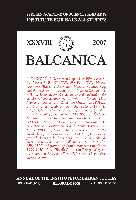Le chemin vers la démocratie. Le développement constitutionnel de la Serbie 1869–1903
The Road to Democracy. The Development of Constitutionalism in Serbia 1869–1903
Author(s): Dušan T. BatakovićSubject(s): History
Published by: Balkanološki institut - Srpska akademija nauka i umetnosti
Keywords: constitution; Serbia; democracy;
Summary/Abstract: After the swiftly abolished liberal Constitution of 1835 and the imposed “Turkish” one of 1838 (imposed by the Russians and Ottomans, guarantors of Serbia’’s autonomy granted in 1830, to limit the princely power), the development of constitutionalism in modern Serbia went through several phases. As elsewhere in the Balkans, constitutions usually resulted from a compromise between the ruler and the elites rather than from the will of the people. The 1868 Constitution drew to an extent upon the early nineteenth-century German constitutional monarchies, but, under pressure from the politically mobilized population, the 1888 Constitution, proposed by the Radical Party in response to the egalitarian aspirations of the nation’’s agrarian majority, adopted a French constitutional model — with a unicameral system and frequent coalition governments. Shaped on the model of the Belgian Constitution of 1831, which in its turn was a modified version of the French Charte of 1830, it restored a French influence, expressed for the first time in the 1835 Constitution. The 1888 Constitution was passed by the Grand National Assembly with its five-sixth majority of Radicals, representatives of the agrarian majority. It was soon annulled by the coup d’état of 1894, and the Court-imposed Constitution of 1869 was reinstituted. The Constitution of 1901 was an attempt to introduce a bicameral system as a means of upholding the influential role of the ruler, while limiting that of the Radical Party, which had enjoyed an ample electoral support since the 1888 Constitution. After the assassination in 1903 of the last Obrenović ruler, king Alexander, and his wife, queen Draga, the liberal Constitution of 1888 with minor modifications was reinstituted. Under this Constitution - which is commonly known as the 1903 Constitution and which, during the democratic reign of king Peter I Kardjordjević, was no longer challenged - Serbian democracy remained fragile, because there was no upper house to counteract, as it did in the French Third Republic, the predominantly party-biased way of running the affairs of state.
Journal: BALCANICA
- Issue Year: 2007
- Issue No: 38
- Page Range: 133-173
- Page Count: 40
- Language: French

